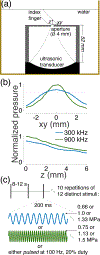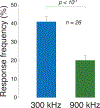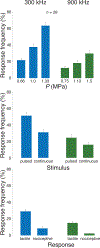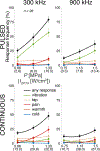Effective Ultrasonic Stimulation in Human Peripheral Nervous System
- PMID: 34057888
- PMCID: PMC9080060
- DOI: 10.1109/TBME.2021.3085170
Effective Ultrasonic Stimulation in Human Peripheral Nervous System
Abstract
Objective: Low-intensity ultrasound can stimulate excitable cells in a noninvasive and targeted manner, but which parameters are effective has remained elusive. This question has been difficult to answer because differences in transducers and parameters-frequency in particular-lead to profound differences in the stimulated tissue volumes. The objective of this study is to control for these differences and evaluate which ultrasound parameters are effective in stimulating excitable cells.
Methods: Here, we stimulated the human peripheral nervous system using a single transducer operating in a range of frequencies, and matched the stimulated volumes with an acoustic aperture.
Results: We found that low frequencies (300 kHz) are substantially more effective in generating tactile and nociceptive responses in humans compared to high frequencies (900 kHz). The strong effect of ultrasound frequency was observed for all pressures tested, for continuous and pulsed stimuli, and for tactile and nociceptive responses.
Conclusion: This prominent effect may be explained by a mechanical force associated with ultrasound. The effect is not due to heating, which would be weaker at the low frequency.
Significance: This controlled study reveals that ultrasonic stimulation of excitable cells is stronger at lower frequencies, which guides the choice of transducer hardware for effective ultrasonic stimulation of the peripheral nervous system in humans.
Figures






Similar articles
-
Influence of the pressure field distribution in transcranial ultrasonic neurostimulation.Med Phys. 2013 Aug;40(8):082902. doi: 10.1118/1.4812423. Med Phys. 2013. PMID: 23927357
-
Radiation Force as a Physical Mechanism for Ultrasonic Neurostimulation of the Ex Vivo Retina.J Neurosci. 2019 Aug 7;39(32):6251-6264. doi: 10.1523/JNEUROSCI.2394-18.2019. Epub 2019 Jun 13. J Neurosci. 2019. PMID: 31196935 Free PMC article.
-
Deployable ultrasound applicators for endoluminal delivery of volumetric hyperthermia.Int J Hyperthermia. 2021 Aug 10;38(1):1188-1204. doi: 10.1080/02656736.2021.1936216. Int J Hyperthermia. 2021. PMID: 34376103 Free PMC article.
-
Miniaturized Intracavitary Forward-Looking Ultrasound Transducer for Tissue Ablation.IEEE Trans Biomed Eng. 2020 Jul;67(7):2084-2093. doi: 10.1109/TBME.2019.2954524. Epub 2019 Nov 22. IEEE Trans Biomed Eng. 2020. PMID: 31765299 Free PMC article.
-
[High-intensity focused ultrasound transducer].Sheng Wu Yi Xue Gong Cheng Xue Za Zhi. 2009 Jun;26(3):667-70. Sheng Wu Yi Xue Gong Cheng Xue Za Zhi. 2009. PMID: 19634694 Review. Chinese.
Cited by
-
Peripheral focused ultrasound stimulation and its applications: From therapeutics to human-computer interaction.Front Neurosci. 2023 Apr 14;17:1115946. doi: 10.3389/fnins.2023.1115946. eCollection 2023. Front Neurosci. 2023. PMID: 37123351 Free PMC article. Review.
-
Remote targeted electrical stimulation.J Neural Eng. 2023 Jun 9;20(3):036030. doi: 10.1088/1741-2552/acd95c. J Neural Eng. 2023. PMID: 37236172 Free PMC article.
-
Controlled ultrasonic interventions through the human skull.Front Hum Neurosci. 2024 Jun 24;18:1412921. doi: 10.3389/fnhum.2024.1412921. eCollection 2024. Front Hum Neurosci. 2024. PMID: 38979100 Free PMC article.
-
Parameter optimisation for mitigating somatosensory confounds during transcranial ultrasonic stimulation.bioRxiv [Preprint]. 2025 Mar 19:2025.03.19.642045. doi: 10.1101/2025.03.19.642045. bioRxiv. 2025. Update in: Brain Stimul. 2025 Jul-Aug;18(4):1224-1236. doi: 10.1016/j.brs.2025.06.009. PMID: 40166137 Free PMC article. Updated. Preprint.
-
Sustained modulation of primate deep brain circuits with focused ultrasonic waves.Brain Stimul. 2023 May-Jun;16(3):798-805. doi: 10.1016/j.brs.2023.04.012. Epub 2023 Apr 18. Brain Stimul. 2023. PMID: 37080427 Free PMC article.
References
-
- Tyler WJ, Lani SW, and Hwang GM, “Ultrasonic modulation of neural circuit activity,” Current opinion in neurobiology, vol. 50, pp. 222–231, 2018. - PubMed
-
- Velling V. and Shklyaruk S, “Modulation of the functional state of the brain with the aid of focused ultrasonic action,” Neuroscience and behavioral physiology, vol. 18, no. 5, pp. 369–375, 1988. - PubMed
Publication types
MeSH terms
Grants and funding
LinkOut - more resources
Full Text Sources
Other Literature Sources

